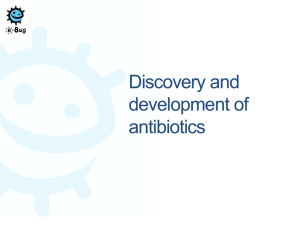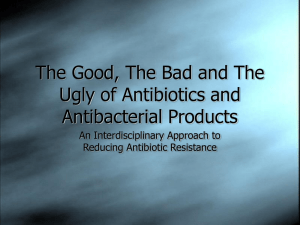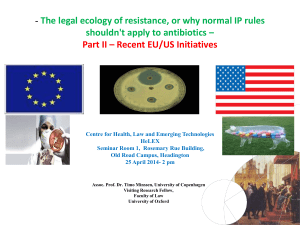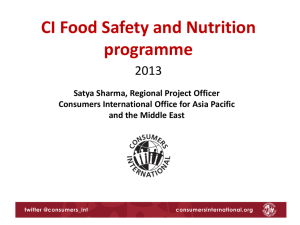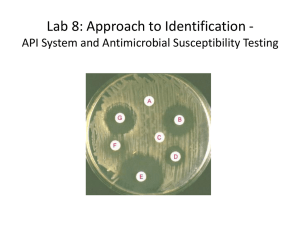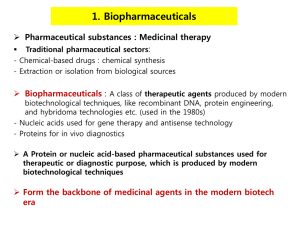Antibiotics in the Environment. - University of Massachusetts Amherst
advertisement
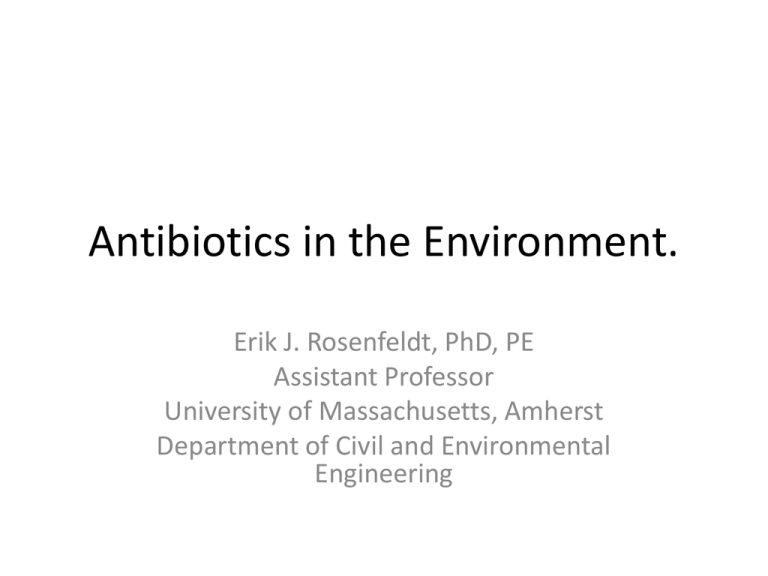
Antibiotics in the Environment. Erik J. Rosenfeldt, PhD, PE Assistant Professor University of Massachusetts, Amherst Department of Civil and Environmental Engineering Me • BS in Chemical Engineering – Washington University in St. Louis, MO • MS in Civil and Environmental Engineering – Duke University, Durham, NC – Thesis: Destruction of Endocrine Disrupting Compounds in Water with Direct UV and UV/H2O2 Advanced Oxidation. • PhD in Civil and Environmental Engineering – Duke University, Durham, NC – Dissertation: UV and UV/H2O2 Advanced Oxidation – A theoretical, practical, and comparative examination of UV processes used to treat emerging contaminants of concern in drinking water. Research Interests • Mitigating threats from Endocrine Disrupting Chemicals (EDCs), Pharmaceuticals and Personal Care Products (PPCPs) in drinking water, wastewater, and reuse water, by combining novel adsorption methods and advanced oxidation processes. • Quantifying advanced oxidation potential in drinking water, wastewater, and reuse water. • UV AOP and alternative oxidation technologies for direct potable reuse applications. • Evaluate strong oxidizing processes to replace traditionally energy intensive regeneration methods for spent zeolite adsorption media. • Assess the ability of several natural zeolite products for removal of water contaminants • Assessing distribution system microbial quality utilizing flow cytometry methods More about Me • Hobbies include running, hiking, basketball, playing with my wife daughter, son and dog Today’s Agenda • 8:45 – 9:00 Introduction • 9:00 – 10:30 Antibiotics in the environment – 9:00 – 9:45: Analyzing for antibiotics in water (presentation) – 9:45 – 10:30: Setting up the lab portion of the course – 10:30: Samples need to be incubating (need 2 hours) • 10:30 – 10:45 Break • 10:45 – 11:45 Issues with Emerging Contaminants in Water (presentation) • 11:45 – 12:00 Break • 12:00 – 1:00 Data analysis and discussion – Take pictures of samples, process pictures – Data Analysis – Discussion Analyzing for Antibiotics in Water Erik Rosenfeldt, PhD, PE Assistant Professor University of Massachusetts, Amherst The story begins… • Penicillin – 1928 – Alexander Flemming found antimicrobial properties of substance exuded from Penicillium notatum (mold) – “might have therapeutic value if it could be produced in quantity.” The story now… • 100,000 – 200,000 tons of antibiotics used worldwide • US Production = 22.7 million kilograms – In US, 70% of dispensed antibiotics are given to healthy livestock to prevent infections and/or promote growth – This practice is outlawed in EU countries Categories of Antibiotics Mode of Action Examples Inhibit Bacterial Cell Wall Biosynthesis b-lacatams, cephalosporins, Human therapeutic and animal glycopeptides, everninomycins therapeutic/ subtherapeutic Block 30S or 50S Ribosomes (inhibit protein synthesis) Macrolides, streptogramins, chloramphenicol, fusidic acid, tetracyclines, lincosamides, aminoglycosides, oxazolidinones, Quinolines, rifamycines Human therapeutic and animal therapeutic/ subtherapeutic Disrupt Integrity of Cell Membranes Antifungal azoles, polyenes Treat fungal infections, topical application for Eczema Antagonize Metabolic Processes Sulfonamides, trimethoprim (TMP) Humans, livestock, aquaculture; TMP and sulfamethoxazole often prescribed together Block Replication of DNA Typical Uses Treat urinary tract, systemic, and respiratory infections Antibiotics in the Environment Antibiotic Manufacturers Livestock Feed Manufacturers Veterinarians Phamacies Livestock Use Human Use Injestion/ Excretion Injestion/ Excretion Treatment of Manure Treated Discharge Land Application of Solids Topical application Flushing unused Municipal WW Individual WW (ie septic) Runoff Treated Discharge Leaching to Groundwater Surface Water Contamination Potential Drinking Water Sources Human Inputs • Excretion of therapeutic antibiotics and metabolites – Many discreted directly in amounts > 40% of ingested dose • Disposal of unused antibiotics – Flushing down the toilet • Washing topically applied antibiotics • All go to septic systems or municipal WWTPs – Inefficient removal – Breeding grounds for antibiotic resistant organisms (ARO) Veterinary Inputs • Antibiotics used in livestock operations since the early 1950s • Used to treat infections, or to improve growth and feed efficiency • Four “types” of AB use in livestock operations – Therapy: Antibiotics for treatment of frank clinical disease – Control: Antibiotics administered to a herd or flock in which morbidity and/or mortality has exceeded baseline norms – Prevention: Antibiotics used in animals considered “at risk”, but where individuals do not show signs of disease – Growth Promotion: Antibiotics administered over a period of time, usually as a feed additive, to growing animals Veterinary Impacts • Antibiotics impact aquatic environment through manure – Large fraction of the medicines present unchanged in animal waste – Direct runoff or collection and use as fertilizer Impacts – Human health concern? • Found at 1 ng/L – 1 ug/L levels in environment • Typical therapeutic doses = 100 – 250 mg per dose (3x per day?) • Need to drink • Not likely an issue Impacts – Microbial Resistance? • Environmental levels have been found to enhance the ability of microorganisms to develop antibiotic resistance – Onan and Lapara (2003), FEMS Microbiology Letters 220: 15 – 20 • Evidence of antibiotic resistant microorganisms has been found in surface wastewater, groundwater, drinking water. – Schwartz et al. (2003), FEMS Microbiology Ecology 43, 325 - 335 Revisit human health concerns? • MRSA (Methicillin Resistant Staphylococcus aureus) – Very difficult to treat – First appeared as hospital derived infection – 1990s – Community associate outbreaks among high risk populations – Today, colonization rates in general population ~ 1.5% – Infections account for majority of skin and soft tissue infections treated in US Emergency Rooms. – In 2005, MRSA caused more deaths in US than AIDS Antibiotic Resistance as a human health concern • Enteric pathogens such as Salmonella and EHEC (Enterohaemorrhagic Escherichia coli) causing illness and treatment failure • Other multi-drug resistant organisms: – Klebsiella pneumoniae, Acinetobacter baumannii, Pseudomonas aeruginosa. • Relatively few pathogens in nature, but… – Antibiotic resistance is transferable!!! How to detect antibiotics in water? • Very sensitive, low level detection available through GC/MS/MS and LC/MS/MS – Example Minimum Reporting Limits (MRLs): • • • • Cyprofloxacin: 20 ng/L Erythromycin: 50 ng/L Sulfamethoxazole: 0.25 ng/L Trimethoprim: 140 ng/L – Approximately $500 - $700 quoted per sample!!!!! What if we could detect overall “antibiotic activity” • Advantages: – – – – – Much cheaper (<$1 per sample) Faster (may get results in a few hours, instead of weeks) Don’t have to ship samples Anyone can do it! Activity might be the only thing that matters • Questions? – Do we really care which antibiotics are in solution? • Different antibiotics act on different parts of the microbe cell • Different antibiotics possess different “strength” – Are there other “antimicrobial agents” in solution? Antibiotic Activity Mode of Action Examples Typical Uses Inhibit Bacterial Cell Wall Biosynthesis b-lacatams, cephalosporins, glycopeptides, everninomycins Human therapeutic and animal therapeutic/ subtherapeutic Block 30S or 50S Ribosomes (inhibit protein synthesis) Macrolides, streptogramins, chloramphenicol, fusidic acid, tetracyclines, lincosamides, aminoglycosides, oxazolidinones, Human therapeutic and animal therapeutic/ subtherapeutic Block Replication of DNA Quinolines, rifamycines Treat urinary tract, systemic, and respiratory infections Disrupt Integrity of Cell Membranes Antifungal azoles, polyenes Treat fungal infections, topical application for Eczema Antagonize Metabolic Processes Sulfonamides, trimethoprim (TMP) Humans, livestock, aquaculture; TMP and sulfamethoxazole often prescribed together We look at other compounds through “activity” • Yeast Estrogen Screen (YES) YES • Advantages: – – – – Cheap (<$1 per sample) Fast (Get results in a few days, instead of weeks) Easy for a grad student to do. Activity might be the only thing that matters (Rosenfeldt et al, 2007) • Questions: – Do we really care about which EDCs are in solution? – Synergistic / Competitive effects? YES Outputs YES Calibration Curves Compound EC50 (nM) E2eq E2 ~0.3 1.0 E1 ~0.21 1.4 EE2 ~0.21 1.4 NP ~1050 0.0003 My Research Question • Is it possible to make a YES-style assay for the detection of Antibiotics in water? – “Inexpensive” – Rapid and convenient – Give us good information for occurrence and treatment studies?? The Antibiotic Challenge (ABC) Assay • Smith et al, 2007 “The development of a rapid screening technique to measure antibiotic activity in effluents and surface water samples” • Utilized the fact that the meat and dairy industry regularly (in EU) and semi-regularly (in US) tests for antibiotic residues. – Commercially available kits have been created to ease this process for meat and dairy producers (ie farmers, not cows) Smith et al, 2007 • Utilized the Premitest, from DSM food industries (Netherlands) – Designed to test meat for the presence of antibiotics • Made slight modifications to test water samples – Add a little “synthetic meat” – Extract and concentrate samples How does the Premitest work? • Uses a rapidly growing, thermophilic bacteria as the indicator – Bacillus stearothermophilus • Responsive to all of the most commonly used antibiotics (ie easy to kill) • Provides a measurable color change in the agar substrate when not exposed to antibiotics • As Bacillus grow, they release acid products – Acid makes color change (just like pH indicators) • If Bacillus growth inhibited, less grow, less acid, less color change Smith et al, 2007 (cont) • Identified a qualitative “calibration curve” Color Antibiotic effect (%) Yellow Yellow with 50/50 some purple Purple with some yellow Purple 0 25 50 75 100 Comparative erythromycin potency (mg/L) <25 40 50.7 63 >100 Comparative sulfamethoxazole potency (mg/L) <40 40 100 155 >250 Smith et al, 2007 (cont.) • Calibration curves • Surface Water Samples Other similar antibiotic activity assays Antibiotic Manufacturer Time per test Detection Assay Delvotest SP DSM 2.5 hours Kit Premitest DSM 3.5 hours Copan Italia 2.5 – 3 hours SpA Charm Farm Charm 2.5 – 3 hours Test Sciences Charm AIM – Charm 4 hours 96 Sciences Copan test Antibiotic Tested Reaction Type Broad Spectrum Broad Spectrum Broad Spectrum Broad Spectrum Broad Spectrum Color Change Color Change Color Change Color Change/ pH Change Color Change Our Procedure • “Delvotest P-Mini” – Sensitive to many antibiotics – Initial kit comes with several boxes worth of tests along with a block heater for ~ $100. – Cost of 25 ampules = ~ $30 - $35 – Color Change takes ~ 2 – 2.5 hours • Advantages over Premitest – Initial tests indicate no additional materials needed • Comes with “nutrient pellets” Procedure • Step 1: Preparation Cut off the required number of ampoules with a pair of scissors. Be careful not to damage the foil of the remaining ampoules. • Step 2: Open the seal Open ampoule(s) by punching a hole in the aluminum foil with the syringe. Mark the ampoules for sample identification. • Step 3: Take a milk water sample Attach a new disposable pipette to the syringe. Depress the plunger completely, dip the tip in the milk sample and allow the plunger to return slowly under pressure of the spring. Procedure • Step 4: Inoculation Empty the syringe into the correspondingly marked ampoule by slowly depressing the plunger of the syringe. Use a fresh disposable pipette for each sample. • Step 5: Incubation Check the temperature of the incubator (64ºC ±0.5ºC). Put the ampoule(s) into the incubator. Record the time and set timer for 3 hours or use control time. • Step 6: Results After 3 hours, remove the samples from the incubator. Read the colour of the lower 2/3 part of the solid agar in the ampoule(s) after the required incubation time. Data Analysis • Collect digital image of the vials – Digital Photo – Image Scanner • Create .pdf file • Analyse image for color using “colors.exe” – http://www.isao.com/pica.html – Otaka I, Kumagai K, Inagaki Y, Shimoyama M, Saegusa K, Hara T (2002) Simple and inexpensive software designed for the evaluation of color American Journal of Ophthalmology 133 (1): 140 – 142. • Vector Analysis to quantify response Digital Images Positive Control Negative Control “Real Images” • Full Test (Amoxicillin in DI water) • Images of groups of vials 0.5, 1, 1 and 4 µg/L 6, 8, 10 and 20 µg/L Positive control Data Analysis Data Analysis • Trim the image and analyze the R, G, B contribution of the average image • ie, R = 0.74, G = 0.59, B = 0.63 Data Analysis • Create a “3-D” plot of the data point, with Red, Green, Blue as the axes • Vector Analysis to analyze distance from – Negative Control to the Data Point (Segment 1) – Data Point to Positive Control (Segment 2) Red Seg 2 Seg 1 Negative Control Positive Control Data Point Blue Green Data Analysis • Comparison of Response curve of Pennicillin dissolved in lab water and Quabbin water 1 0.9 0.8 y = 3.9578x R² = 0.947 Fractional Response 0.7 y = 3.648x R² = 0.9935 0.6 Very minimal interference in “pristine, natural water” 0.5 0.4 Penicillin in DI 0.3 Penicillin in Natural Water 0.2 0.1 0 0 0.05 0.1 0.15 Disolved Penicillin (mg/L) 0.2 0.25 Today’s Experiment • 3 groups • 1 group will be creating a calibration curve – Positive (50 mg/L Penicillin), Negative (0 Penicillin) – 100, 250, 400, 500, 700, 1000 ng/L • 1 group will investigate potentially negative activity impact of synthetic estrogen – Positive (50 mg/L Penicillin), Negative (0 Penicillin) – 1000 ng/L Penicillin + 50, 100, 250, 500, 1000, 2000 ng/L EE2) • 1 group will investigate potential false positives (H2O2) – Positive (50 mg/L Penicillin), Negative (0 Penicillin) – 0 ng/L Penicillin + 2, 5, 10, 50, 100, 250 mg/L H2O2 Hypotheses? • Addition of a compound with unrelated activity can negatively impact activity of an antibiotic • Addition of an inorganic antimicrobial agent (H2O2) will not interfere with assay at “low” concentrations – Optimistic??

